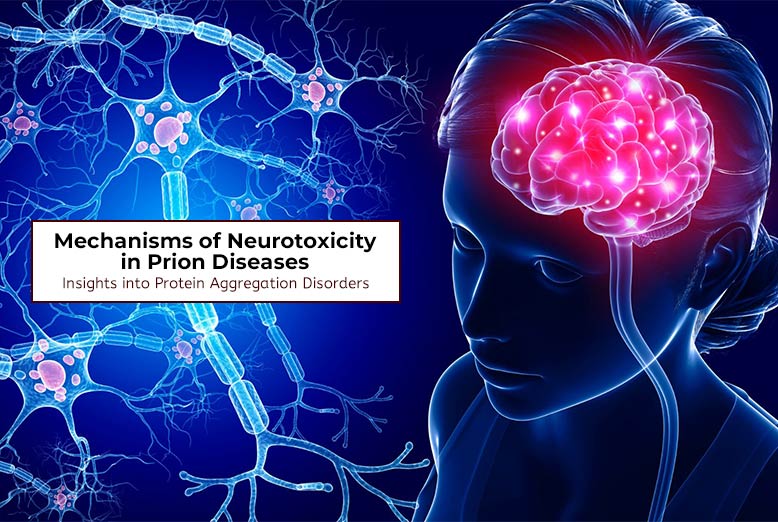Transmissible spongiform encephalopathies (TSEs), commonly known as prion diseases, are a group of fatal neurodegenerative disorders that affect both humans and animals. These diseases, including Creutzfeldt-Jakob disease (CJD) in humans and scrapie in sheep, are characterized by the accumulation of misfolded prion proteins (PrP^Sc) in the brain. The neurotoxic effects of these misfolded proteins lead to progressive neuronal damage and death. Understanding the mechanisms of neurotoxicity in prion diseases provides valuable insights into protein aggregation disorders and offers potential avenues for therapeutic intervention. This article explores the key mechanisms underlying neurotoxicity in prion diseases and their implications for other protein aggregation disorders.
Prion Protein Misfolding and Aggregation
The normal, cellular prion protein (PrP^C) is primarily composed of alpha-helical structures and is expressed on the surface of neurons. In prion diseases, PrP^C undergoes a conformational change into a misfolded form known as PrP^Sc. This pathological form is rich in beta-sheet structures, making it insoluble and resistant to protease degradation. The accumulation of PrP^Sc in the brain leads to the formation of insoluble aggregates that are toxic to neurons.
Mechanisms of Neurotoxicity
The neurotoxic effects of prion protein misfolding and aggregation are mediated through several mechanisms:
- Direct Toxicity of PrP^Sc Aggregates: The accumulation of PrP^Sc aggregates in the brain can directly disrupt cellular processes and structures. PrP^Sc aggregates can interact with neuronal membranes, leading to membrane damage and increased permeability. This disruption can result in ion imbalance, mitochondrial dysfunction, and ultimately cell death.
- Proteostasis Imbalance: The accumulation of misfolded prion proteins can overwhelm the cellular machinery responsible for protein folding and degradation, leading to a state of proteostasis imbalance. The unfolded protein response (UPR) and autophagy are critical pathways for maintaining protein homeostasis. In prion diseases, these pathways can become dysregulated, contributing to neuronal stress and toxicity.
- Oxidative Stress: Misfolded prion proteins can induce oxidative stress by generating reactive oxygen species (ROS). Oxidative stress damages cellular components, including lipids, proteins, and DNA, leading to impaired cellular function and neuronal death. Antioxidant defenses may become overwhelmed, exacerbating the neurotoxic effects of prion aggregation.
- Neuroinflammation: Prion diseases are associated with neuroinflammation, characterized by the activation of microglia and astrocytes. These glial cells release pro-inflammatory cytokines and chemokines, which can contribute to neuronal damage. Chronic inflammation can exacerbate the neurotoxic effects of prion aggregation and promote disease progression.
- Synaptic Dysfunction: Prion protein misfolding can disrupt synaptic function and impair neurotransmission. PrP^Sc aggregates can interfere with synaptic vesicle recycling, receptor function, and signal transduction pathways. Synaptic dysfunction is a key feature of prion diseases and contributes to cognitive decline and motor deficits.
Insights into Other Protein Aggregation Disorders
The mechanisms of neurotoxicity in prion diseases share similarities with other protein aggregation disorders, such as Alzheimer’s disease, Parkinson’s disease, and amyotrophic lateral sclerosis (ALS). These disorders are also characterized by the misfolding and aggregation of specific proteins, leading to neurodegeneration. Insights gained from studying prion diseases can inform our understanding of these related conditions:
- Protein Misfolding and Aggregation: Similar to prion diseases, Alzheimer’s disease involves the misfolding and aggregation of beta-amyloid and tau proteins. Parkinson’s disease is characterized by the accumulation of alpha-synuclein, and ALS involves the aggregation of TDP-43 and other proteins. Understanding the common pathways of protein misfolding and aggregation can help identify potential therapeutic targets.
- Proteostasis and Quality Control: The dysregulation of proteostasis pathways, including the UPR and autophagy, is a common feature of many neurodegenerative disorders. Therapeutic strategies aimed at enhancing proteostasis and promoting the clearance of misfolded proteins hold promise for treating these conditions.
- Oxidative Stress and Neuroinflammation: Oxidative stress and neuroinflammation are key contributors to neurodegeneration in prion diseases and other protein aggregation disorders. Targeting these pathways with antioxidants and anti-inflammatory agents may provide neuroprotective benefits.
- Synaptic Health: Synaptic dysfunction is a hallmark of many neurodegenerative diseases. Strategies to preserve synaptic health and function, such as modulating neurotransmitter systems and promoting synaptic plasticity, are important areas of therapeutic research.
Conclusion
The mechanisms of neurotoxicity in prion diseases provide valuable insights into the broader field of protein aggregation disorders. Understanding the pathways through which misfolded prion proteins cause neuronal damage and death can inform the development of therapeutic strategies for prion diseases and related neurodegenerative conditions. Continued research into the molecular mechanisms of prion-induced neurotoxicity holds the promise of advancing our understanding of these devastating disorders and improving patient outcomes.
Also Read: 3 Best Retirement Options for Old Grandpas with Medical Conditions













